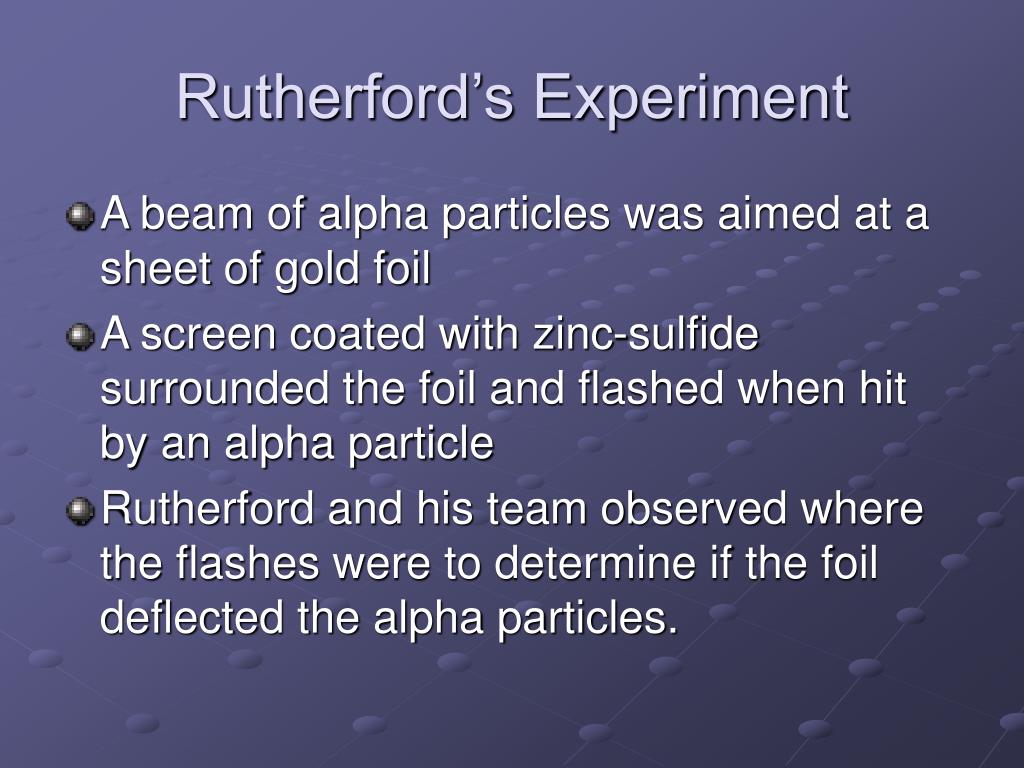
- #Rutherford experiment conclusion manual#
- #Rutherford experiment conclusion series#
- #Rutherford experiment conclusion free#
#Rutherford experiment conclusion free#
If there is something unclear, feel free to post your query. I have written something similar sometimes ago and you can find it here. Thank you for someone who will answer it!!! Is there anything wrong with my answer? I really got confused cuzĪ : therefore most of the particles just pass through the gold foil or deflected with negligible angleĬ : again, very few particles just came straight back if the nucleus was charged negatively then it would absorb the alpha particles and the angle of deflection would be less than 90 cuz a negative charge attracts a positively charged particleĭ : Charge and Mass are Concentrated at the Centre and again most of the particles just passed through therefore atom is generally an empty space and the nucleus is very small comapred to atom. The radiation was focused into a narrow beam after passing through a slit in a lead screen.Which of the following is not a valid conclusion from Rutherford’s alpha particle scattering experimentī The mass of the atom is mostly concentrated in the nucleus.Ĭ The nucleus must be positively charged.ĭ The nucleus must be very small compared to the atom
#Rutherford experiment conclusion series#
The nucleus was postulated as small and dense to account for the scattering of alpha particles from thin gold foil, as observed in a series of experiments performed by undergraduate Ernest Marsden under the direction of Rutherford and German physicist Hans Geiger in 1909.Ī radioactive source emitting alpha particles (i.e., positively charged particles, identical to the helium atom nucleus and 7,000 times more massive than electrons) was enclosed within a protective lead shield. Rutherford Experiment Conclusion Series Of Experiments Niels Bohr Read more about Danish physicist Niels Bohr, the first physicist to apply quantum theory to the problem of atomic structure. In Bohrs model the orbits of the electrons were explained by quantum mechanics.

What was the impact of Ernest Rutherfords theory The gold-foil experiment showed that the atom consists of a small, massive, positively charged nucleus with the negatively charged electrons being at a great distance from the centre.

Quantum Read about the theory used in the Bohr model to more correctly describe the structure of atoms. In the Bohr model, which used quantum theory, the electrons exist only in specific orbits and can move between these orbits.Įlectromagnetic radiation Learn more about electromagnetic radiation and why it posed a problem for Ernest Rutherfords atomic model. This meant that an electron circling the nucleus would give off electromagnetic radiation. Most of the mass is in the nucleus, and the nucleus is positively charged.īut the Rutherford atomic model used classical physics and not quantum mechanics. What did Ernest Rutherfords atomic model get right and wrong The Rutherford atomic model was correct in that the atom is mostly empty space. Thomson atomic model Read about the Thomson atomic modelthe earliest model of atomic structureand how Ernest Rutherfords gold-foil experiment disproved it.īohr model Learn about Niels Bohrs atomic model and how it differs from Ernest Rutherfords atomic model.


The Bohr atomic model, relying on quantum mechanics, built upon the Rutherford model to explain the orbits of electrons. What were the results of Rutherfords experiment The previous model of the atom, the Thomson atomic model, or the plum pudding model, in which negatively charged electrons were like the plums in the atoms positively charged pudding, was disproved. The only way this would happen was if the atom had a small, heavy region of positive charge inside it.Īlpha particle Learn about the particles used in the Rutherford gold-foil experiment. What is the Rutherford gold-foil experiment A piece of gold foil was hit with alpha particles, which have a positive charge. The neutron had not been discovered when Rutherford proposed his model, which had a nucleus consisting only of protons.Įrnest Rutherford Read more about Ernest Rutherford, the physicist whose gold-foil experiment revealed key information about the structure of atoms.
#Rutherford experiment conclusion manual#


 0 kommentar(er)
0 kommentar(er)
